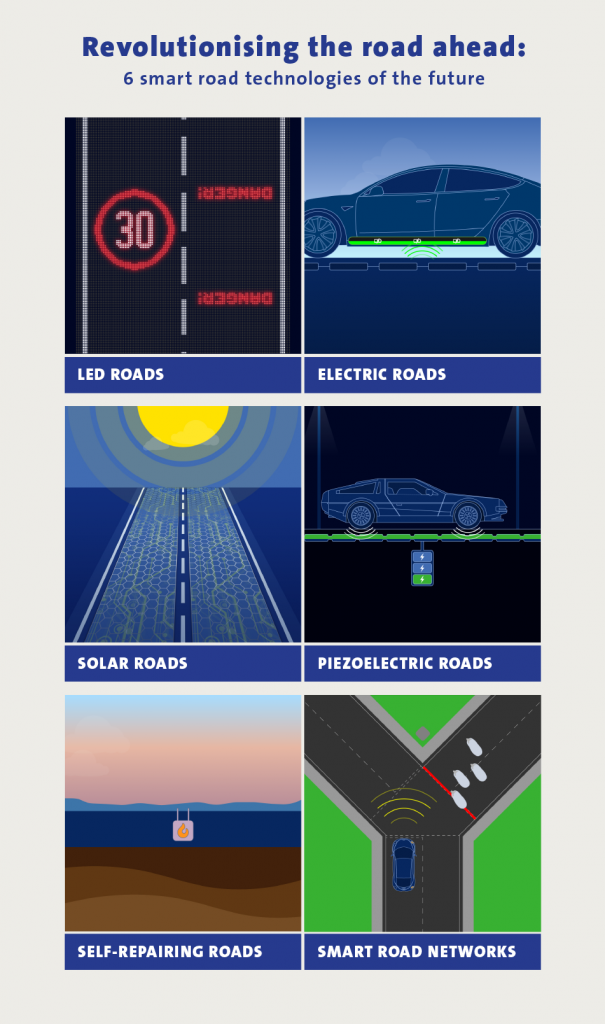In a glance towards the future of road transport, Compare the Market has explored 6 smart road technologies that are currently in development around the world to see what roads around the world could look like in the years to come.
Top 6 Smart Roads Technologies
The roads have been designed as GIFs, and include the following technologies:
- Solar roads
- LED roads
- Electric roads
- Piezoelectric roads
- Self-repairing roads
- Smart road networks
Two of these technologies can be effective in generating energy for the cities in which they operate.
Piezoelectric roads, for example, are currently being piloted in California[1] and use special crystals situated under the road’s surface to harness energy from traffic.[2]
Solar roads generate energy in a different manner by replacing typical road materials with special-made solar panels. These are able to withstand foot and vehicle traffic without breaking and could meet energy demands up to three times over, at just 15% efficiency.[3]
Solar roads come with complications such as shade interruptions prohibiting them from effectively absorbing sunlight, meaning they may not be ready for large-scale use until such issues can be overcome. Trials such as the 2016 experiment in Tourouvre-au-Perche, France, support the theory that more work needs to be done on solar roads before they can truly be effective.[4]
LED roads provide an opportunity to improve visibility of road markings during inclement weather as well as providing real-time road closures when obstructions are in the way. They could eliminate the need for traffic controllers setting up road cones or barrier fences, by having roads display warnings to drivers at the touch of a button. With the use of adaptive algorithms and Artificial Intelligence programs, LED roads can also save electricity by only lighting up when cars drive on them.[5]
A unique piece of technology being trialled in countries such as the Netherlands and China is self-repairing roads.[6] Special asphalt mixtures are used to build roads, which can be automatically melted and reformed after being activated by damage sensors, taking roughly three hours (depending on conditions).[7] Not only could this technology reduce roadworks and congestion, it’s also estimated that having worldwide self-repairing roads could reduce global emissions by 16% and lower infrastructure spending by 32%.[8]
Electric roads extend the battery life of electric vehicles by charging them as they drive. While there are trials of these roads throughout Europe, they require a physical connection and effective wireless technology is yet to be developed. Once implemented, wireless electric roads could revolutionise the way electric cars operate in the future.
Possibly one of the more complex technologies in development, smart road networks utilise software programs, sensors and wireless networks to share important information between gadgets in nanoseconds, commonly known as ‘the internet of things’.[9] With computers within vehicles being able to connect to the road, traffic flows can be managed by means of self-driving cars adapting courses during times of congestion or allowing emergency service vehicles to pass.[10]

To view GIFs that visualise how each of these pieces of technology work, please visit: https://www.comparethemarket.com.au/car-insurance/smart-road-tech/
About comparethemarket.com.au
Comparethemarket.com.au is a comparison service that takes the hard work out of shopping around. We make it Simples for Australians to quickly and easily compare and buy insurance, energy, travel and personal finance products from a wide range of providers. Our easy-to-use comparison tool enables consumers to find products that best suit their needs and back pocket.
[1] IEEE Spectrum – Good Vibrations? California to Test Using Road Rumbles as a Power Source: https://spectrum.ieee.org/cars-that-think/transportation/infrastructure/good-vibrations-california-to-test-road-vibrations-as-a-power-source
[2] International Journal of Advance Research in Science and Engineering – Piezoelectric Roads: http://www.ijarse.com/images/fullpdf/1504679409_CIET_009.pdf
[3] International Journal of Engineering Research and Applications – “Solar Roadways” – Rebuilding our Infrastructure and Economy: https://www.ijera.com/papers/Vol3_issue3/IJ3314291436.pdf
[4] The Conversation – Solar panels replaces tarmac on a road – here are the results: https://theconversation.com/solar-panels-replaced-tarmac-on-a-road-here-are-the-results-103568
[5] ARPN Journal of Engineering and Applied Sciences – Smart roadways lighting prototype system for public awareness: http://www.arpnjournals.org/jeas/research_papers/rp_2016/jeas_0816_4764.pdf
[6] Engineering – The Smart Road: Practice and Concept: https://www.researchgate.net/publication/326528252_The_Smart_Road_Practice_and_Concept
[7] Journal of Cleaner Production – The healing capability of asphalt pavements: A state of the art review: https://www.researchgate.net/publication/287974378_The_healing_capability_of_asphalt_pavements_A_state_of_the_art_review
[8] Environmental Research Letters – Consequences of long-term infrastructure decisions—the case of self-healing roads and their CO2 emissions: https://iopscience.iop.org/article/10.1088/1748-9326/ab424a
[9] Electronic – Interference Analysis for Vehicle-to-Vehicle Communications at 28 GHz: https://www.mdpi.com/2079-9292/9/2/262
[10] IEEE Access – Vehicle Automation – Other Road User Communication and Coordination: Theory and Mechanisms: https://ieeexplore.ieee.org/document/8968342
















